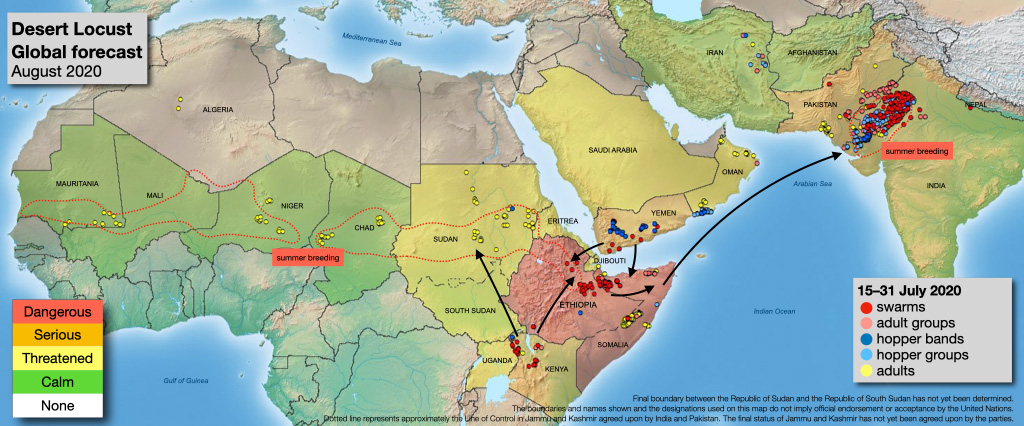I'm sure Albert has some Monaco garden acreage he could turn over to the voracious hoppy - fly-y creatures.
From PoAndPo Agrifish:
Large numbers of desert locust swarms that have formed in Horn of Africa (HoA), mainly Ethiopia and Kenya, since January 2020 could move west in the coming weeks, threatening fields, pastures and livelihoods in West Africa.
The FAO, which noted the full extent of the desert locust swarm warning, stressed its latest situation update on Sunday that national surveillance operations are in full swing, and control measures are ready because of the major early warning and rapid response effort coordinated by FAO.Here's Locust Watch and their latest map:
"We have witnessed the unprecedented desert locust threat to food security and livelihoods in East Africa, and we are doing everything we can to prevent a similar crisis repeating in the Sahel region, which is already experiencing several ongoing crises," a FAO statement read.
According to FAO's desert locust watch, swarms that bred in spring in East Africa are now shifting to the summer breeding areas, and countries west of the HoA should remain on high alert.
The FAO also noted that most of the swarms in northwest Kenya are expected to ride winds carrying them north to cross South Sudan into Sudan.
"Unless it rains more in Sudan's desert, providing favorable breeding conditions for the pests, the locusts will not stay in Sudan for long and would instead move west through the Sahel of West Africa in search of food and favorable breeding areas," it added....MORE
Desert Locust situation update 3 August 2020
The locust situation remains a cause of extreme concern in the Horn of Africa and southwest Asia.
Second-generation spring swarms continue to decline in northwest Kenya due to control operations and migration northwards. A few swarms last crossed into northeast Uganda on 22 July. At least one swarm appeared on 1 August in the southeast of South Sudan near Kapoeta in East Equatoria, and control operations are underway. A few more swarms could appear in the coming days and transit South Sudan to reach the summer breeding areas in Sudan. Other immature swarms have migrated northwards to Ethiopia to join existing swarms, some of which moved into the northern Ethiopian highlands and northwest Somalia where control operations continue against hopper bands and swarms. Two swarms from Yemen invaded northeast Ethiopia at the end of July. In southern Oman, control operations are in progress against local breeding near Salalah.
Some of the swarms that continued east across northern Somalia may still reach India and Pakistan in early August. Thereafter, the threat should lessen especially as good rains are predicted to fall in northern Somalia in the coming weeks that would allow the swarms to mature and lay eggs....MORE
